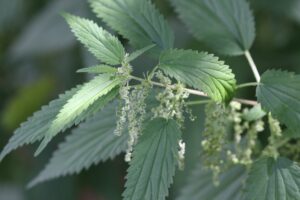Stinging nettle is a perennial that grows across Canada, and has a defense mechanism to protect them from being eaten. It can be found growing in moist areas: along rivers and streams and in ditches. It can also grow in open woodlands, farmyards and old pastures.
Stinging nettles grow to a height of approximately 1-2 metres. They have heart shaped leaves that grow in pairs on opposite sides of the stem. The flowers are small and green-white in colour. The stem of the plant and the underside of the leaves are covered in long, thin, hollow hairs called trichomes. If you rub against or touch the plant the trichomes can become detached. The trichomes act like tiny needles — injecting chemicals (formic acid, histamine and others) into the skin, which causes the stinging feeling.

What is the reaction?
The initial reaction is a painful sting which lasts for a few minutes. The initial reaction is followed by reddish swelling with white and red spots and prolonged itching. If there is prolonged exposure to the plant the reaction will intensify and can last for several days.
What to do if you come into contact with stinging nettle?
- Wash the area with soap and water. Try to wait 10 minutes after contacting the plant to allow for the chemicals to dry, which makes it easier to wash off.
- Avoid scratching/rubbing the itchy area. This can push the chemicals deeper into the skin and cause the reaction to last longer.
- If the reaction continues for several hours contact a medical provider.
If the reaction remains painful or itchy after washing the area then you can try applying a cool compress or dabbing on a paste made of baking soda and water.
Contact one of our pharmacists today if you have any questions about stinging nettle.
